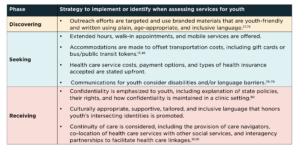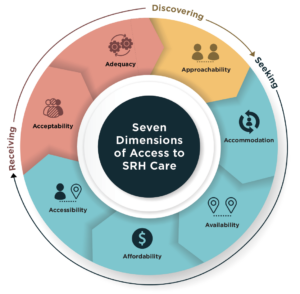 Accommodation: The extent to which service providers consider young people’s needs and preferences, as well as the constraints that limit their options for care
Accommodation: The extent to which service providers consider young people’s needs and preferences, as well as the constraints that limit their options for care
Health care services are often delivered in ways that are not youth-centered (i.e., a lack of consideration for school, work, or other commitments that limit availability; use of medical jargon or technical terms difficult to understand; or requiring in-person visits to be seen). For example, youth experiencing homelessness and youth in foster care may not have learned how to identify a health care provider, schedule a medical appointment, or otherwise navigate the health care system.30,32 Lack of knowledge about their personal and family medical history can make it difficult for these young people to complete medical intake forms.30,33 Youth experiencing homelessness may have trouble accessing health care services because many lack a state ID or proof of health insurance.30 Limited availability of walk-in appointments, hours that conflict with young people’s school or work schedules, and the lack of a primary health care provider lead many youth experiencing homelessness to rely on emergency departments for their health care.30,34-35
 Availability: The extent to which providers offer the health care services youth need
Availability: The extent to which providers offer the health care services youth need
The availability of sexual and reproductive health care is affected by policies that either mandate or restrict access.30,36 Some policies affect youth involved in a particular system. For example, a study conducted in 2021 across 17 juvenile detention and committed centers in California, Maryland, and Georgia found variation in the services provided to pregnant youth, even though all facilities offered obstetric and gynecological care. These discrepancies resulted in differing availability of on- or off-site OB/GYNs, pregnancy testing, and abortions (including the requirement of judge approval).37 Meanwhile, youth who are under court supervision but not incarcerated are left to address their sexual and reproductive health on their own, since they are not protected under the same mandates as those in detention facilities that require such care.10,38
With the recent policy changes in the last five years mainly focused on abortion care, gender-affirming care, and trans health care, the current literature around availability of services centers these topics. Policies, like those related to abortion care, may affect all youth regardless of the system with which they are involved. Obtaining abortion care has become increasingly difficult for youth in states that have moved to restrict health providers’ discretion and imposed other restrictions.39 The availability of abortion care is particularly limited for youth in the 15 states with near-total abortion bans,40 who often lack the means to travel across state lines41—particularly for youth in foster care and youth experiencing homelessness. In states with less restrictive policies, most minors cannot have an abortion without the consent or notification of a parent or legal guardian, or a judge’s permission in the case of a judicial bypass.41-43 For youth who are homeless and estranged from their parent or legal guardian or who are wards of the state, parent approval acts as a barrier, could present harm to the youth, and in some cases could be nearly impossible to acquire.44-45 Also, the availability of gender-affirming care for youth varies widely by state, with 35 percent of transgender youth ages 13 to 17 living in one of the 22 states that ban the provision of gender-affirming care for minors.40,46-48 The imposition of these bans is particularly concerning for youth in foster care and youth experiencing homelessness because transgender youth are overrepresented among both populations.
 Affordability: The extent to which the cost of services is aligned with young people’s ability to pay
Affordability: The extent to which the cost of services is aligned with young people’s ability to pay
Health insurance coverage is a primary determinant of sexual and reproductive health care affordability, particularly for youth.28,49 Young people are typically covered by Medicaid while they are in foster care and continue to be eligible for Medicaid until their 26th birthday if they age out of care.31 Young people involved with the justice system may have access to sexual and reproductive health care while they are detained or incarcerated but may lack health insurance when they are living in their communities, which can result in discontinuity of care.49-50 Young people experiencing homelessness may be covered by their parent/caregiver’s insurance but may not possess proof of insurance or other important documentation needed to utilize their coverage.51 They may also be eligible for Medicaid if they live in a state that has enacted Medicaid expansion, although several states have declined to expand Medicaid in recent years.51-52 In 2010, the Patient Protection and Affordable Care Act expanded access to health insurance among young people and required that contraception and some preventative sexual and reproductive health services are covered by insurance; however, young people must be insured to take advantage of this.52 The Hyde Amendment and additional state laws prohibit the use of federal funds and federally funded health care for abortion care, except in cases of rape, incest, or a life-threatening pregnancy. This makes it difficult if not impossible for young people in the Bureau of Federal Prisons, those with Medicaid, and even young people with private insurance to obtain affordable abortion care.52
Out-of-pocket expenses such as coinsurance payments, as well as transportation costs, can also limit young people’s ability to access sexual and reproductive health care.28,53 To mitigate issues related to affordability, Gallardo and colleagues found that health care providers used funds from multiple state and federal grants and collaborated across health care organizations to address the health care needs of youth experiencing homelessness.30 Similarly, abortion funds can facilitate access to abortion care,54 especially for young people who are uninsured or who live in states that restrict public or private insurance coverage of abortion care.55
 Accessibility: The extent to which the location of services is reachable
Accessibility: The extent to which the location of services is reachable
The physical location of a clinic is an important factor to consider for youth. Lack of transportation can be a barrier for youth who don’t live near a clinic and rely on family or friends or public transportation to get to appointments.56-58 Youth are also vulnerable to sudden moves to communities where sexual and reproductive health care is inaccessible, which can interrupt the continuity of their care. For example, youth in foster care may be moved from one placement to another, youth experiencing homelessness may be forced to move due to shelter stay limits, and youth in the juvenile justice system may be moved from a detention facility back into the community.32,59-61 In addition to a clinic being centrally located or reachable by public transit, it is necessary to account for the physical safety of the environment for youth. Current research does not specifically discuss physical safety related to accessing sexual and reproductive health care, but it has been linked to whether youth decide to engage in a program or access a service of any type.62 Although studies have shown that telehealth can increase the accessibility of sexual health services and information for adolescents,63 a study of young people experiencing food and housing insecurity found that they perceived greater barriers to accessing contraceptives via telehealth than their peers.64



 Accommodation: The extent to which service providers consider young people’s needs and preferences, as well as the constraints that limit their options for care
Accommodation: The extent to which service providers consider young people’s needs and preferences, as well as the constraints that limit their options for care Availability: The extent to which providers offer the health care services youth need
Availability: The extent to which providers offer the health care services youth need Affordability: The extent to which the cost of services is aligned with young people’s ability to pay
Affordability: The extent to which the cost of services is aligned with young people’s ability to pay Acceptability: The extent to which health care service providers recognize, consider, and honor cultural, social, and individual factors
Acceptability: The extent to which health care service providers recognize, consider, and honor cultural, social, and individual factors Adequacy: The extent to which the health care services provided are appropriate, timely, integrated, and continuous
Adequacy: The extent to which the health care services provided are appropriate, timely, integrated, and continuous